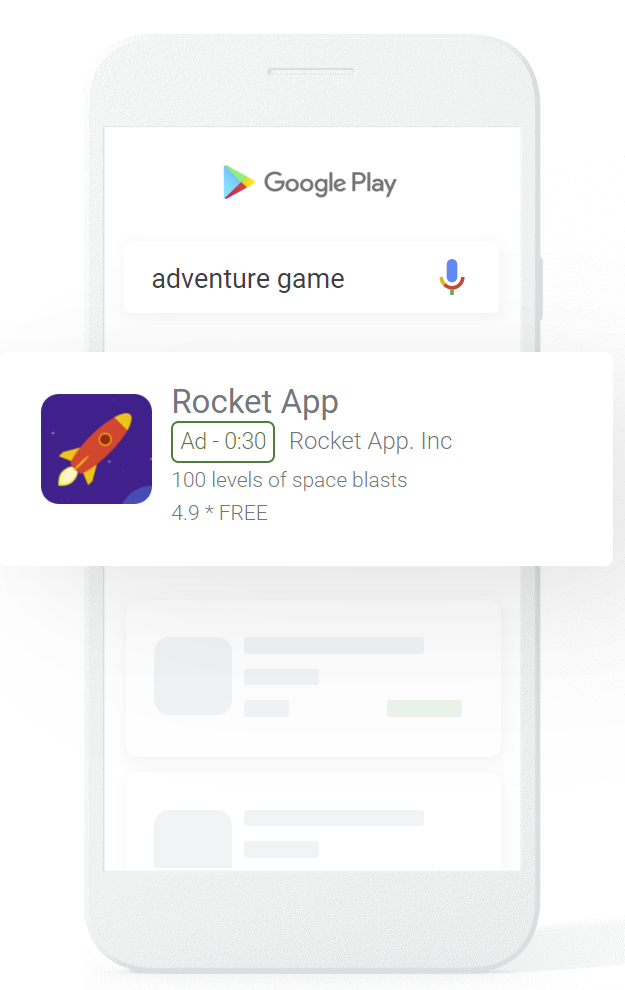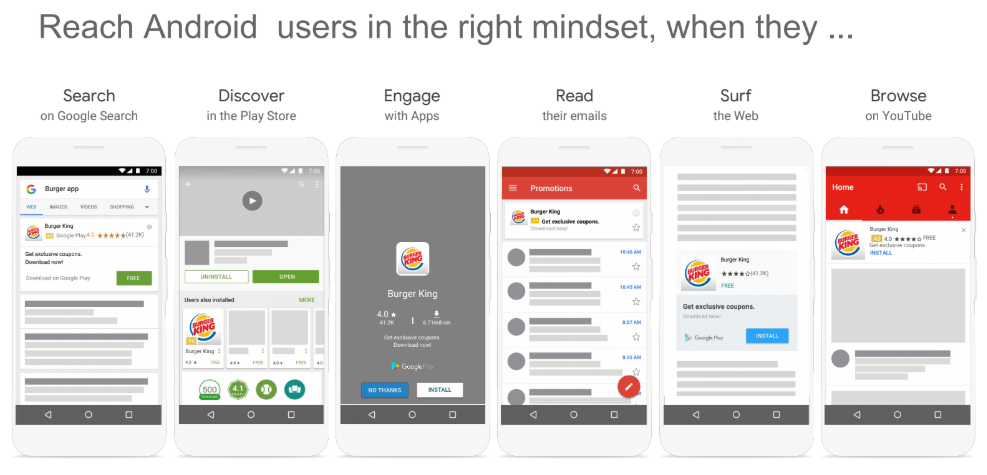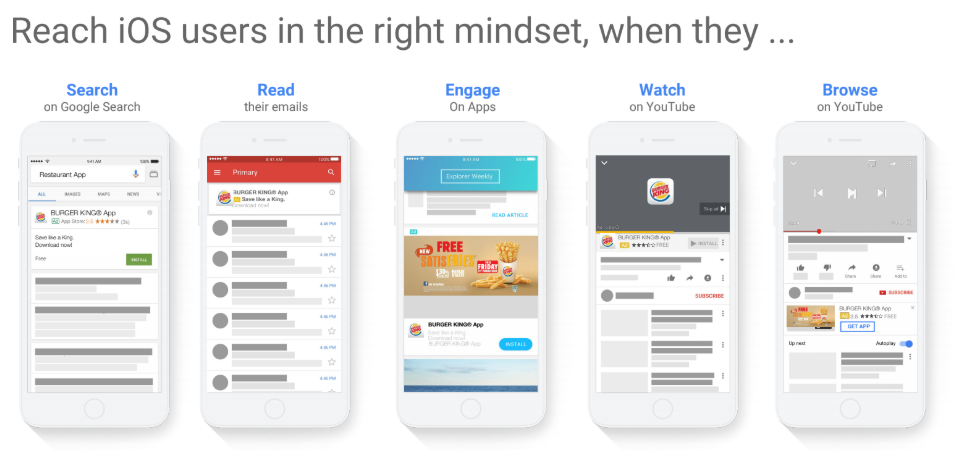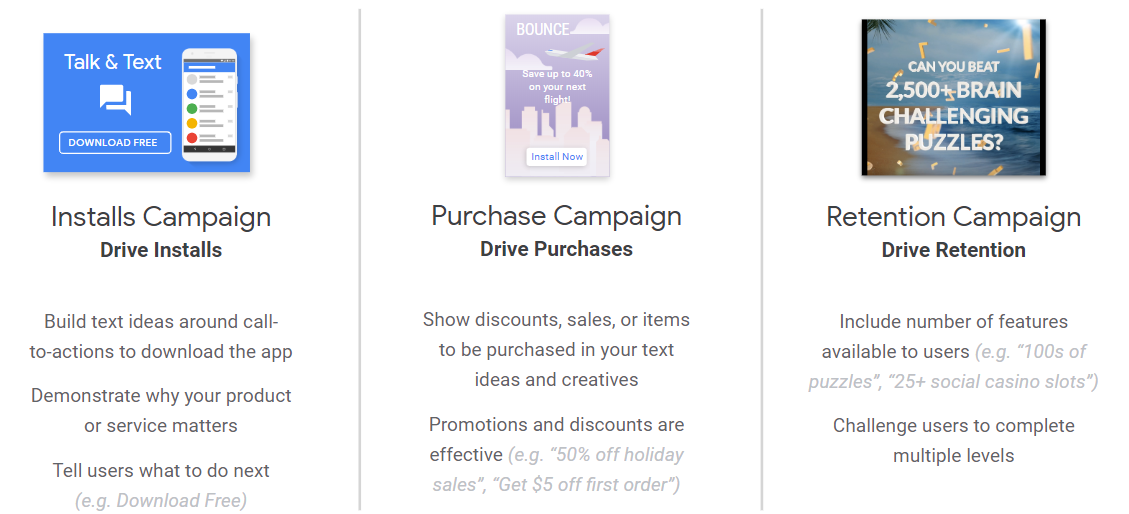Google App Campaigns (Google AC): How-to & 5 Expert Strategies

Google App Campaigns (formerly Universal App Campaigns, or UAC) are one of the best ways to reach new users with your mobile app.
What makes Google App Campaigns special is that you can surface your mobile app advertisements across Search, Google Display Network, Gmail, Google Play Store, YouTube — making Google AC a flagship component for any mobile app marketing strategy.
Here’s everything you need to know about Google App Campaigns (Google AC): how they work, where they display, and five strategies to get the most out of your app marketing campaigns.
“Google App Campaigns are essential for advertisers looking to drive traffic to their app. GAC drives significant and quality volume for brands by maximizing creative through ad groups and maintaining optimal budgets and bids. Not only does GAC drive efficient CPAs, but it also allows brands to scale when lower funnel tactics see less demand.”

— Jessie Stenklyft, Senior Paid Search Strategist at Tinuiti
Google App Campaigns (formerly Google Universal App Campaigns or UAC) are mobile app ad campaigns that can be used to reach consumers across Google’s digital properties to drive app install and in-app actions.

First launched in 2015, Google App Campaigns have become an important component for any brand with intentions of acquiring new users and growing the lifecycle of their mobile app.
Google AC can be used both for app install campaigns and to drive in-app conversions. Google uses machine learning to identify your most successful ad campaigns and showcase them where they will perform best.
What makes Google App Campaigns unique is that, unlike Apple Search Ads, they can display beyond the Play Store and across Google’s Search, Display, and YouTube network.


Google App Campaigns can reach users across Search, Display, YouTube, and more:
“With Google App Campaigns, marketers have the ability to open up their app’s user base to additional sources of inventory and serve on some of Google’s app-exclusive networks creating additional exposure and daily activity in a space where the tide is clearly still rising. Additionally, GAC allows marketers to leverage Google’s machine learning to learn more about their customer base and ensure they’re targeting relevant users.”

— Parker Brown, Paid Search Specialist at Tinuiti
Setting up a Google App Campaign is easy and can take just minutes if you already know your objective.
You Set Your Inputs & Let Google’s Machine Learning Test and Optimize
You choose a goal for your app campaign, update your ad assets, and specify your target cost-per-install or cost-per-action as well as a maximum daily budget. If you don’t have any creative assets specified, Google will automatically select videos or images from your listing on the Google Play Store.
Google App Campaigns remove the need for manual testing. Instead, brands supply Google with multiple lines of text and other mixed media assets such as video or images. Google then creates multiple ads from your media inventory and displays them to figure out which ones are most successful.
Even though Google does most of the hard work, there are still some ways to make sure you’re getting the most out of your ads. Let’s take a look at our favorite five ways to optimize your Google App Campaigns.
When assigning goals to your Google App Campaigns, it’s important to choose assets that align with those goals.

The three main ad marketing goals typically fall under three categories:
Install Campaigns: If app installs are the main goal of your app campaigns, you’ll want to run an install campaign that solves a pain point among your audience and gives users a reason to install your app.
Purchase Campaigns: These campaigns are designed to persuade users to make an in-app purchase, so displaying attractive creative and enticing offers will help to drive conversions.
Retention Campaigns: If longevity is your goal, it’s important to incorporate features that keep users interested and engaged with your product.
Google can take up to a week to get a grasp on how your ads are doing, so it’s important to have a budget high enough for it to gain an accurate gauge of how your ad is performing.
This usually means setting a minimum daily budget that is at least 50x that of your CPI target or 10x that of your CPA target so that it has a sufficient amount of volume per day to meet that target.
Conversely, setting this budget cap will also limit Google from spending more money than you’re comfortable with while figuring out how each ad performs. By keeping this budget requirement for at least two weeks, you’ll give Google enough ad spend to keep an accurate track of your app install campaigns while preventing overspend.
Just because Google can automatically optimize your ads doesn’t mean your work is done. While it can select the best mix of options from your media inventory, it’s limited solely to that inventory.
We’ve seen creative completely change the game for campaigns in terms of performance. It’s also extremely important to make sure you are utilizing the different image sizes and video aspect ratios for your creative. Different sizes of these creative types unlock different inventory. If you’re only using square images and square videos, you aren’t reaching full volume potential because you don’t have access to a banner image or portrait video inventory.
“With Google AC, one of the most important and powerful levers for performance is having a pipeline of creative to continually test, find success, and iterate off of that. We have the ability to help brands choose which in-app events make the most sense as well as assist in creative strategy & production.”

— Kaitlyn Shimazaki, Paid Search Strategist at Tinuiti
This makes it important for brands to experiment constantly with different types of text and media.
Google App Campaigns allow you to upload 4 lines of text, 20 videos, and 20 images, so taking advantage of all of these different testing options and constantly switching out assets will allow you to create the most optimal ad campaign.
Video is extremely effective at drawing in leads―they can boost your conversion rates as high as 80%.
However, not all videos perform equally, making it important to diversify and test out different video types.
According to Google, optimal videos show the experience of the app as quickly as possible.
This can include consumers interacting with the app, showing hands, as well as effective use of music audio that can engage your audience.
Tracking in-app events can be extremely valuable, as app installs alone don’t indicate a healthy app lifecycle. It takes engagement, action, and actual in-app events to drive impact for your brand.
“With in-app event selection, making sure you identify a few different in-app events to optimize towards is really important. You don’t want to select the end goal to start as that can limit volume & won’t allow for Google AC machine learning to work properly.”

— Kaitlyn Shimazaki, Paid Search Strategist at Tinuiti
For more down-funnel app event tracking, you’ll need to work with a mobile measurement partner.
If you’re interested in increasing app installs or in-app events, Google App Campaigns (Google UAC) are one of the most cost-effective ways to drive users towards action. Not only do they give you optimized ad campaigns, but they also free up time that would otherwise be used manually creating and testing separate ads.
This doesn’t mean Google App Campaigns can just be set up and forgotten about, however. Periodic text and media testing will keep your ads fresh and provide relevant data to support your mobile app marketing strategy.
Want to learn more?
The Beginner’s Guide to Mobile App Marketing
Apple Search Ads: The Complete Guide [2020 Update]
The 7-Step Guide to App Store Optimization (ASO)
GAMMA Leaders: Liz Emery & Mobile App Marketing
